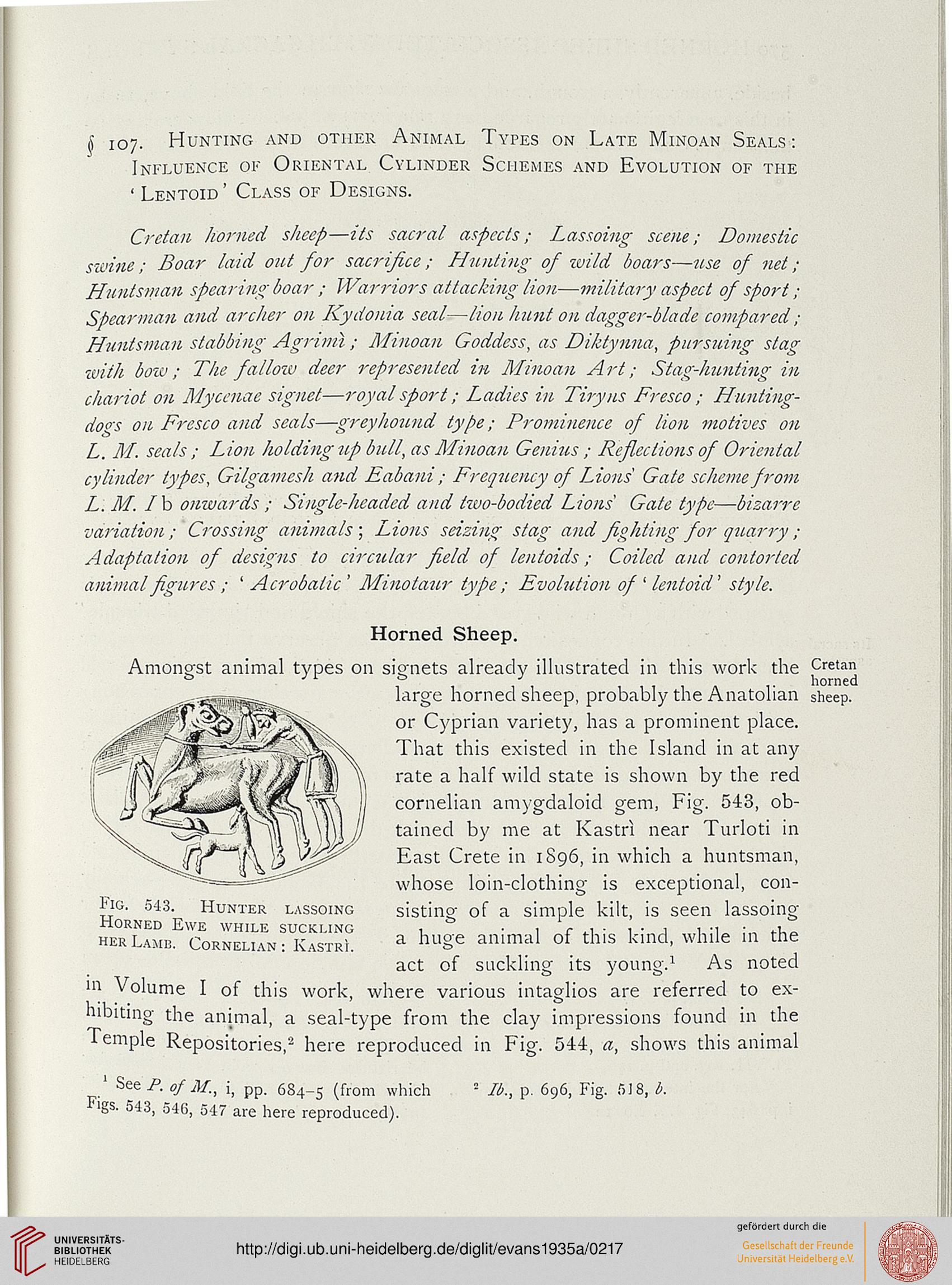S 107. Hunting and other Animal Types on Late Minoan Seals:
Influence of Oriental Cylinder Schemes and Evolution of the
' Lentoid' Class of Designs.
Cretan homed sheep—its sacral aspects; Lassoing scene; Domestic
swine; Boar laid out for sacrifice; Hunting of wild boars—use of net;
Huntsman spearing boar ; Warriors attacking lion—military aspect of sport;
Spearman and archer on Kydonia seal—lion hunt on dagger-blade compared;
Huntsman stabbing Agriml; Minoan Goddess, as Diktynna, pursuing stag
with bozo; The fallow deer represented in Minoan Art; Stag-hunting in
chariot on Mycenae signet—royal sport; Ladies in Tiryus Fresco ; Hunting-
dogs on Fresco and seals—-greyhound type; Prominence of lion motives on
L. M. seals ; Lion holding up bull, as Minoan Genius ; Reflections of Oriental
cylinder types, Gilgamesh and Eabaui ; Frequency of Lions' Gate scheme from
L. M. Ih onwards ; Single-headed and two-bodied Lions' Gate type—bizarre
variation; Crossing animals; Lions seizing stag and fighting for quarry;
Adaptation of designs to circular field of lentoids; Coiled and contorted
animal figures ; ' Acrobatic ' Minotaur type ; Evolution of ' lentoid' style.
Horned Sheep.
Among-st animal types on signets already illustrated in this work the Cretan
1 ■ , , 1 , , 1 1 a v horned
large horned sheep, probably the Anatolian sheep.
or Cyprian variety, has a prominent place.
That this existed in the Island in at any
rate a half wild state is shown by the red
cornelian amygdaloid gem, Fig. 543, ob-
tained by me at Kastri near Turloti in
East Crete in 1896, in which a huntsman,
whose loin-clothing is exceptional, con-
sisting of a simple kilt, is seen lassoing
a huge animal of this kind, while in the
act of suckling its young.1 As noted
in Volume I of this work, where various intaglios are referred to ex-
hibiting the animal, a seal-type from the clay impressions found in the
Temple Repositories,2 here reproduced in Fig. 544, a, shows this animal
Fig. 543. Hunter lassoing
Horned Ewe while suckling
her Lame. Cornelian : Kastri.
1 Seei>. of M., i, pp. 684-5 (from which
''gs. 543, 546, 547 are here reproduced).
lb., p. 696, Fig. 518, It.
Influence of Oriental Cylinder Schemes and Evolution of the
' Lentoid' Class of Designs.
Cretan homed sheep—its sacral aspects; Lassoing scene; Domestic
swine; Boar laid out for sacrifice; Hunting of wild boars—use of net;
Huntsman spearing boar ; Warriors attacking lion—military aspect of sport;
Spearman and archer on Kydonia seal—lion hunt on dagger-blade compared;
Huntsman stabbing Agriml; Minoan Goddess, as Diktynna, pursuing stag
with bozo; The fallow deer represented in Minoan Art; Stag-hunting in
chariot on Mycenae signet—royal sport; Ladies in Tiryus Fresco ; Hunting-
dogs on Fresco and seals—-greyhound type; Prominence of lion motives on
L. M. seals ; Lion holding up bull, as Minoan Genius ; Reflections of Oriental
cylinder types, Gilgamesh and Eabaui ; Frequency of Lions' Gate scheme from
L. M. Ih onwards ; Single-headed and two-bodied Lions' Gate type—bizarre
variation; Crossing animals; Lions seizing stag and fighting for quarry;
Adaptation of designs to circular field of lentoids; Coiled and contorted
animal figures ; ' Acrobatic ' Minotaur type ; Evolution of ' lentoid' style.
Horned Sheep.
Among-st animal types on signets already illustrated in this work the Cretan
1 ■ , , 1 , , 1 1 a v horned
large horned sheep, probably the Anatolian sheep.
or Cyprian variety, has a prominent place.
That this existed in the Island in at any
rate a half wild state is shown by the red
cornelian amygdaloid gem, Fig. 543, ob-
tained by me at Kastri near Turloti in
East Crete in 1896, in which a huntsman,
whose loin-clothing is exceptional, con-
sisting of a simple kilt, is seen lassoing
a huge animal of this kind, while in the
act of suckling its young.1 As noted
in Volume I of this work, where various intaglios are referred to ex-
hibiting the animal, a seal-type from the clay impressions found in the
Temple Repositories,2 here reproduced in Fig. 544, a, shows this animal
Fig. 543. Hunter lassoing
Horned Ewe while suckling
her Lame. Cornelian : Kastri.
1 Seei>. of M., i, pp. 684-5 (from which
''gs. 543, 546, 547 are here reproduced).
lb., p. 696, Fig. 518, It.





